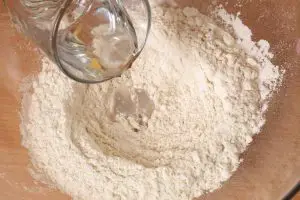It is possible that dough will not reach the windowpane stage for various reasons. If your bread does not reach this stage, it does not necessarily imply that it was unsuccessful. The completion of the “ideal” windowpane does not imply that bulk fermentation has ended.
To determine how effectively the gluten has evolved, this test is performed. Because the two issues are so similar, they are frequently mistaken. Gas should be detected in the dough after the too-bulky fermentation stage to signal the end of the stage. The degree of “gassiness” produced by the bread varies on the type of bread being produced.
It is necessary to achieve both a stretchy gluten structure and the required quantity of gassiness simultaneously. Following the fulfillment of these requirements, the dough is formed and final proofed.
What is the Windowpane Test?
Take a tiny piece of your dough and stretch it out to make a thin membrane around your fingertip. A transparent ‘windowpane’ should be formed by thinning the dough out to allow light to flow through it. In other words, the dough should be stretchy enough to make a translucent ‘windowpane.’
Five Reasons Why Dough Doesn’t Pass the Windowpane Test
1. Checking at Wrong Stage
Testing the dough after the mixing process and during the bulk fermentation process is necessary. It is unnecessary to have the dough at the translucent stage when it comes out of the mixing bowl unless a short bulk fermentation is performed afterward. During the bulk fermentation process, the gluten structure will continue to grow.
Make sure your dough reaches stage 4 on the windowpane test table, and then leave it to rest and bulk ferment for a few hours or overnight. Throughout the bulk fermentation, keep an eye on everything. Regardless of whether the dough is gassy and must be shaped before the windowpane can be obtained, shape it anyway. Next time, knead the dough or apply additional stretch and folds to help the gluten develop even more.
2. Not Kneading Enough
The most evident explanation for the lack of development of a gluten matrix is a lack of sufficient kneading. At first, use a moderate force mix to slowly hydrate the wheat and combine the contents into the flour. Halfway through, switch to a more forceful mode of action. The dough needs to be kneaded for at least 8 minutes in a dough mixer or at least 15 minutes by hand to create a windowpane.
3. Not Enough Gluten Available
If you want to get to the windowpane stage, the flour you use must be appropriate for the recipe. Short/zero bulk fermentation necessitates a high protein flour with a protein content of around 13 percent.
Protein flours with lower protein content can be utilized for longer bulk fermentation. Many damaged proteins can be found in low-quality flours. This requires patience since some strands are so damaged that they never recover. Finding a reputable flour brand is critical to producing excellent bread.
4. Dough Is Too Cold
It is possible that chilly temperatures can create gluten formation troubles if you are attempting a no-knead recipe (or even a light knead recipe) followed by a lengthy bulk fermentation. A frequent and helpful technique for reducing the fermentation rate is to place the container in the refrigerator.
However, the dough must be let rest at room temperature for a period for amylase and the yeast to act properly. We require these two to work hard to create the dough! A dough thermometer is the best way to ensure your dough is at the ideal temperature to work with.
5. Dough Needs More Water
A certain amount of water must be present for the gluten strands to stretch adequately. It is possible to use too little water and prevent the gluten from getting stretchy, preventing it from reaching the windowpane stage.
The use of excessively wet dough is likewise problematic. A large amount of water in a dough might function as a lubricant, preventing the gluten network from joining properly. After lengthy bulk fermentation, wet doughs may be able to redeem themselves.
Organic acids in the dough that form throughout the fermentation process boost the dough’s ability to retain water. They also aid in the cohesiveness of the dough. Organic activity is required for the dough to develop and strengthen the gluten structure. Even though a lengthy bulk fermentation can address this, it is still feasible for rapid bread to be made in this manner.
We can utilize preferments to infuse organic acids and hydrated gluten into the dough, which will shorten the time required for the initial rise. The mature dough that has been introduced acts as a natural dough conditioner and aids in the development of gluten. When the dough has had time to form correctly, you may expect a superior crumb structure and a crisp crust.






